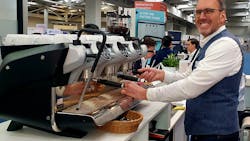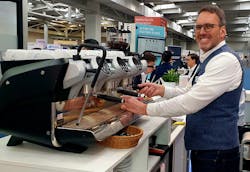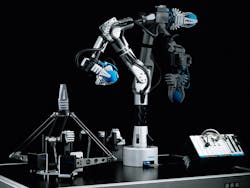Hannover Messe 2023 Booth Tour: How Enterprises Embed and Unleash AI
At the same time as our fascination and fear of trending generative AI systems heat up, researchers focused on the industrial manufacturing realm are bolstering their AI toolkits—all the better to be part of the next wave of innovation.
Recognizing the practical potential and revealing the breadth of problems that the machine learning techniques behind generative AI can solve was ample reason to make it a core topic at Hannover Messe 2023, the international tradeshow for industrial transformation, which took place in Germany (April 17-21, 2023).
Generative AI, a subset of machine learning, is crucial to the future of industrial business, from manufacturing and automotive to aerospace and defense. With help from generative AI, the industry can, for example, explore different designs and speed up simulation to a degree that engineers can iterate 100 different designs in a given timeframe, while finding the optimum design for a particular component or application. “AI really helps to make those design cycles faster, and the output—fingers crossed—better,” said Boris Scharinger, senior innovation manager, Siemens, during a presentation.
READ MORE: Digital Twin, Hold the Sugar
The objective for Siemens, according to Scharinger, has been to reach “industrial grade,” a term he coined to refer to the output quality of AI solutions. “We could all be driving autonomous cars, but if I look at you, no one here today arrived in an autonomous car,” he said. “Why is that? Because we don’t trust that bloody thing yet. If we don’t trust it yet, we all need to work as much as the automotive industry does on the autonomous car to make AI industrial. So that’s partly our mission.”
For Scharinger, the problem of developing industrial-grade AI is not unique to Siemens. Rather, scaling qualitative AI solutions that meet manufacturing demands is a universal challenge. In the interim, he said, solutions remain stuck in test lab environments. The near-term goal, said Scharinger, should be to see industrial grade AI emerge from that space.
On the tradeshow floor, where Scharinger’s high-level observations were in play, vendors demonstrated the multitude of ways they apply AI in broad industrial applications, while striving to make their solutions economical through automation.
Two notable takeaways emerged from this year’s show: The first is that, in tandem with connectivity, the talent of training robots is an important lever in driving big business and shifting the labor pool. The second is that finding a way to bring it to the shop floor remains a stumbling block for the masses.
In this analysis of emergent technologies below, we trace the promise and pitfalls of AI and machine learning at this year’s fair.
Pick-and-Place AI in the Chocolate Factory
Rather than teach the robot to grasp, Siemens fed their robots millions of examples of how to grasp an object. Using neural networks, the robot learns to grasp a given object based on an image database.
A neural network is a complex algorithm that can learn tasks by analyzing vast amounts of data. The algorithm learns to recognize an object (for instance: a human, a dog, a chocolate bar, a microchip) by looking at thousands of labelled photos. The dataset of input-output relationships is programmed to predict the specific output for a given task (or output). Deep learning stems from the fact that the examples were first created in simulation in the virtual world. When the neural network is plugged into the robot, it is able to master the task of grasping physical objects in the real world.
The deep learning approach isn’t new. Siemens showcased the algorithm’s capabilities through its SIMATIC S7-1500 TM NPU object-recognition product at Hannover Fair 2019. Back then it was a first step in the direction of adaptive automation.
This year, reinforcement learning played a more prominent role. Siemens characterized it as a framework that enables robots to learn behaviors through interactions with its surroundings. The key focus in reinforcement learning is to provide robot controllers with “high-level specifications of what to do instead of how to do it,” noted Siemens. As the robot learns independently, the payoff is higher yields.
During Scharinger’s presentation, he demonstrated Siemens’ efforts to meet “industrial grade” by pointing to a use case of a pick-and-place conveyor belt system used for recognizing and sorting chocolate bars. In his example, the optimized control algorithm was not connected to a tool system, but to a digital twin of a conveyor belt that was exactly matched to the actual conveyor’s light barriers, IOs and electrical drives.
READ MORE: Hannover Messe Wraps up on an “Optimistic” Note
After 72 hours of training on the digital twin, the AI had learned key sequences that allowed it to control the real machine. Not only could it perform such functions as aligning the chocolate bars in the same direction and positioning them at equal distances, but it could also run in the cycle time of the actual PLC. This solution is integrated with Siemens’ SIMATIC portfolio.
A shortcoming of reinforcement learning has been limited adoption, mainly due to the large amounts of data needed to get robots to execute tasks properly and to successfully learn control policies. Siemens researchers have also set their sights on a combined method, known as residual learning, which requires only a fraction of the samples needed in reinforcement learning. In this approach the robot’s task is approached with conventional feedback control (that is, position control) and is augmented by residual learning.
Digital Twin Barista
A coffee break at the Altair booth would likely be accompanied by a gratis lesson on how to enhance the performance and energy efficiency of a coffee machine. Known for its simulation, high-performance computing (HPC) and artificial intelligence (AI) solutions, Altair has been working with Gruppo Cimbali, an Italian industrial coffee machine manufacturer, to develop a digital twin-driven process for the lifecycle management of the coffee machine.
“The goal of this project was to reduce the energy consumption of the machine and optimize thermal management,” said Christoph Donker, director, EMEA Marketing, Altair. “Several parts of the machine were losing temperature. With the help of the digital twin, we identified those parts of the machine and optimized it.”
Information about each drink crafted is logged into a database, along with insights about the drink’s quality to ultimately improve daily management, explained Donker.
Engineers were not only able to simulate the entire system with the help of Altair’s open integration and simulation platform, Altair Activate, but also reduced the number of physical prototypes. Time to market for the coffee machine is 30% faster than it was before and energy consumption was reduced by 25%.
Simulations like the coffee machine project are entirely transferable. By creating fully automatic professional espresso coffee based on IoT functionalities, Gruppo Cimbali now also has a way to expand into telemetry markets and expand its offerings to innovative management, display and data representation systems for Wi-Fi-connected machines.
READ MORE: Hannover Messe Builds Anticipation for New Technologies and Production Methods
Technologies that build digital twins can be applied to almost any machine and are effective for extending the remaining useful life of a product without the use of a physical prototype, Donker explained. Altair also works with automotive, aerospace and defense and machine building industries.
“The next project involving the coffee machine might be to capture data—such as the grading of the coffee beans or the temperature during the coffee-making process—and then optimize the whole process again,” Donker said.
R&D Meets the Marketplace
The increasing complexity of products spurs the need to use AI solutions to stay competitive and set the pace for the working world of the future. At the it’s OWL stand, 33 companies and 19 research institutions and networks converged to demonstrate how to tap into AI-based solutions to design and operate production in a sustainable manner. KI MarktPlatz, or AI Marketplace—a platform covering the whole value chain from engineering through production and logistics—ensures secure data exchange and data sovereignty, in addition to the intelligent matching of AI service providers and companies.
In the past, the goal was to digitalize companies. That perspective has changed with the goal to work toward sustainability, pointed out Salome Lessmann, marketing manager, KI MarktPlatz. “It’s not just technology for technology’s sake, but more with the higher purpose of sustainability,” she said. “Our focus on solutions for Industry Zero is a nod to Industry 4.0. The idea is to go towards zero waste, zero emissions, zero unemployment.”
When AI is used in engineering, it can improve sustainability, Lessman explained further. In generative design, this process saves materials through light-weighting or the simulation of energy efficiency. Then, through testbed performance, the researchers can draw conclusions on resource efficiency. User companies harness the platform’s expertise gleaned from 11 years of experience and 300 projects worth €200 million to date, as well as the partner network it provides to implement the efficiency gains.
Lessman said collaborations with the technology network means customers can pool resources and leverage the three prerequisites for using AI: AI expertise, data and the culture of innovation. In one exhibit, where AI and machine learning were used to reduce production times at an early stage in the engineering, researchers performed a systems analysis of requirements and developed proposals for particular parts of the client’s production system.
READ MORE: IT/OT Convergence at Hannover Messe
Another partner, Beckhoff Automation, demonstrated its modular XTS (extended transport system), a mechatronic linear transport solution, which consists of magnetically driven movers that pass along a path at up to 4 m/s. The hardware required for the transmission technology is integrated into the motor module and implemented in TwinCAT. The flexible configuration means the mover can transport, move, handle and measure individually. The system was expanded with NCT (no cable technology) to include a special motor module as well as electronics that can be mounted on the movers.
Depending on the requirements, the number of movers on the system can be changed, so the system can be optimized for sustainability. An increase current consumption by the mover, for example, can mean increased friction, noted Beckhoff’s subject matter experts. Designers looking for resource efficiency and energy savings would take advantage of the compact design, as well as tap into the data from the controller and additional sensors as the basis for diagnostics and the detection of system changes at an early stage. This, in turn, will decrease downtime.
Unresolved Issues Resolved
Last year, Festo invested about 7% in R&D. Part of that spend was allocated for what to do to get AI directly in the production process. At an area designated for Industrial Transformation at the Festo booth, subject matter experts explained how digitalization and AI can optimize machine and system control. Consider as an example the software GripperAI from Festo.
The autonomous solution enables “blind bin picking” or self-directed picking with robots, cobots or Cartesian gantry. GripperAI follows an autonomous learning scheme to recognize and grip unfamiliar objects, a functionality Festo touts as unprecedented. With conventional solutions, vision systems or robots learn either based on images or CAD, or manually teaching the robot’s movements through image recognition and gripping point calculation.
Depending on the level of flexibility required, a tool change can be triggered by the end-effector. New functions such as positioning and feeding can be realized by the module, too. Implementation is flexible and can be done on the gripper itself via RaspberryPI, on a PC on the robot or in the camera, or a cloud connection can be established. According to Festo’s press notes, a partnership with ibk Ingenieur Consult GmbH will allow the robot supplier to bring an online configurable robot cell to market as an entry-level model.
Visit Machine Design's Hannover Messe hub for more event coverage.
About the Author

Rehana Begg
Editor-in-Chief, Machine Design
As Machine Design’s content lead, Rehana Begg is tasked with elevating the voice of the design and multi-disciplinary engineer in the face of digital transformation and engineering innovation. Begg has more than 24 years of editorial experience and has spent the past decade in the trenches of industrial manufacturing, focusing on new technologies, manufacturing innovation and business. Her B2B career has taken her from corporate boardrooms to plant floors and underground mining stopes, covering everything from automation & IIoT, robotics, mechanical design and additive manufacturing to plant operations, maintenance, reliability and continuous improvement. Begg holds an MBA, a Master of Journalism degree, and a BA (Hons.) in Political Science. She is committed to lifelong learning and feeds her passion for innovation in publishing, transparent science and clear communication by attending relevant conferences and seminars/workshops.
Follow Rehana Begg via the following social media handles:
X: @rehanabegg
LinkedIn: @rehanabegg and @MachineDesign




